Botany Final Exam study Guide
1/276
Name | Mastery | Learn | Test | Matching | Spaced |
|---|
No study sessions yet.
277 Terms
evolutionary development
(Evo-Devo) - the study of the evolution of developmental patterns.
Great strides have been made by studying conserved genes. Much of what we know about developmental gene regulation comes from studying mutations that disrupt normal embryo development
conserved genes
genes with similar DNA sequences in distantly related organisms that regulate key developmental pathways
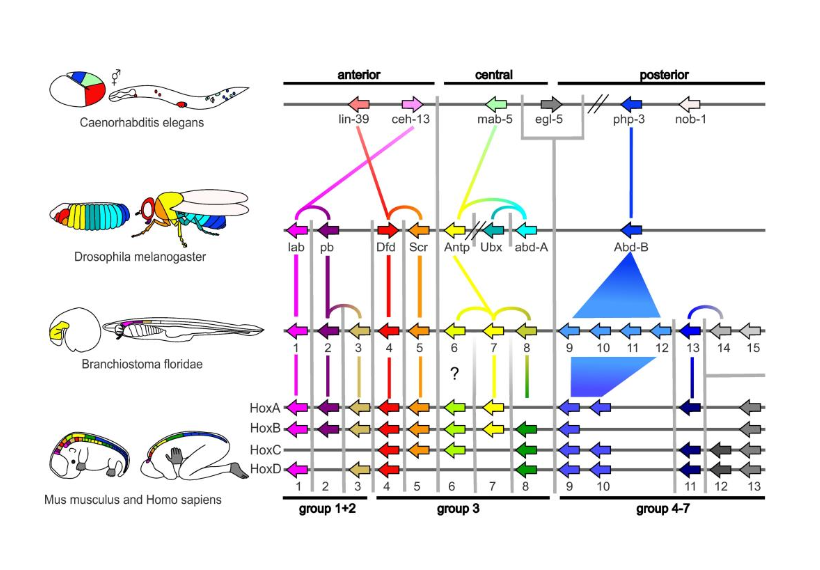
embryogenesis
formation of the embryo
the first two stages of seed development.
Establishes the body plan of the plant, which consists of two superimposed patterns: apical/basal and radial
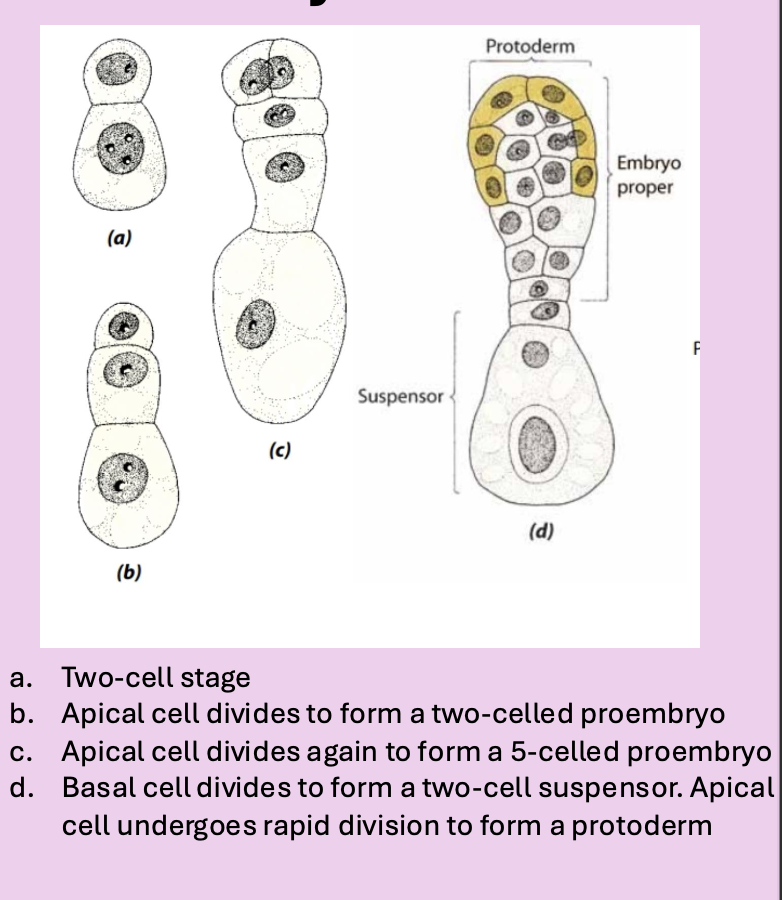
apical-basal pattern
pattern that is found along the main axis and establishes polarity.
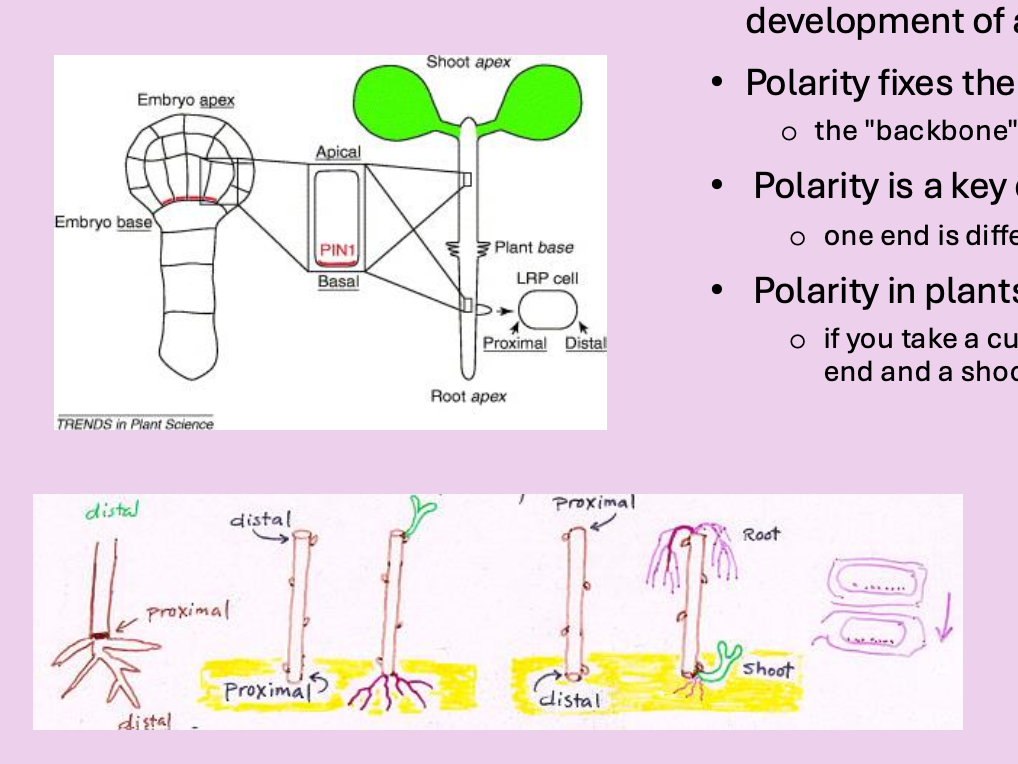
apical cell
one of two daughter cells (apical and basal) of fertilized zygote
gives rise to most of the mature embryo
basal cell
the other of two cells arising from the original zygote
gives rise to a stalk-like suspensor that anchors the embryo at the micropyle
radial pattern
concentrically arranged tissue system that consists of three tissue types (the
primary meristems):
protoderm
ground meristem
procambium
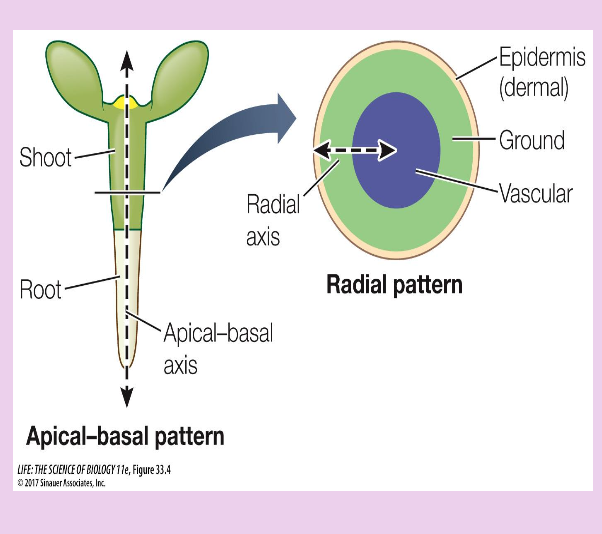
protoderm
outer tissue layer in embryo. Precursor to the epidermis
ground meristem
middle tissue layer in embryo. Precursor to the ground tissue.
Surrounds the procambium
procambium
inner tissue layer. Precursor to the vascular tissues
globular stage
Embryo is spherical and displays apical-basal pattern, but cells are undifferentiated
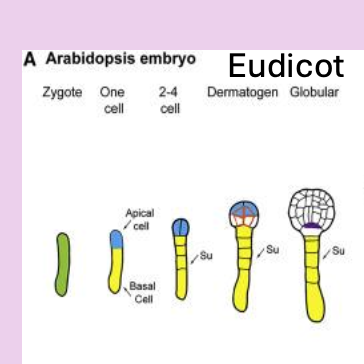
heart stage
radial polarity is established.
Cotyledon(s) begin to develop, in eudicots forming a heart shape.
Apical and root meristems begin to form
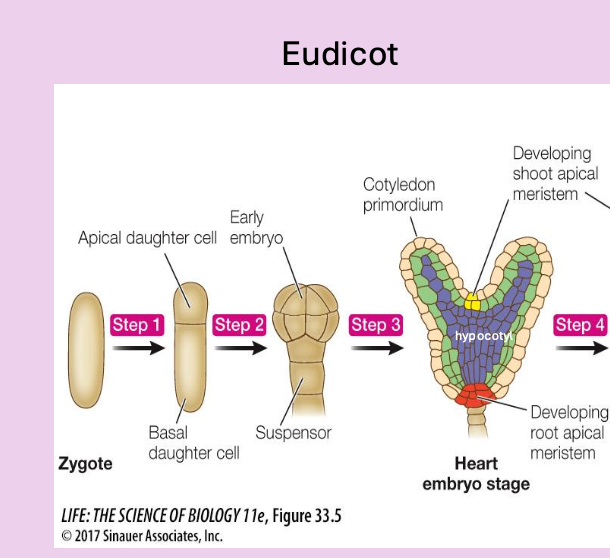
torpedo stage
embryo is partitioned into: meristems, elongated cotyledon(s), and hypocotyl.
Suspensor dissolves. Embryo may begin to curve.
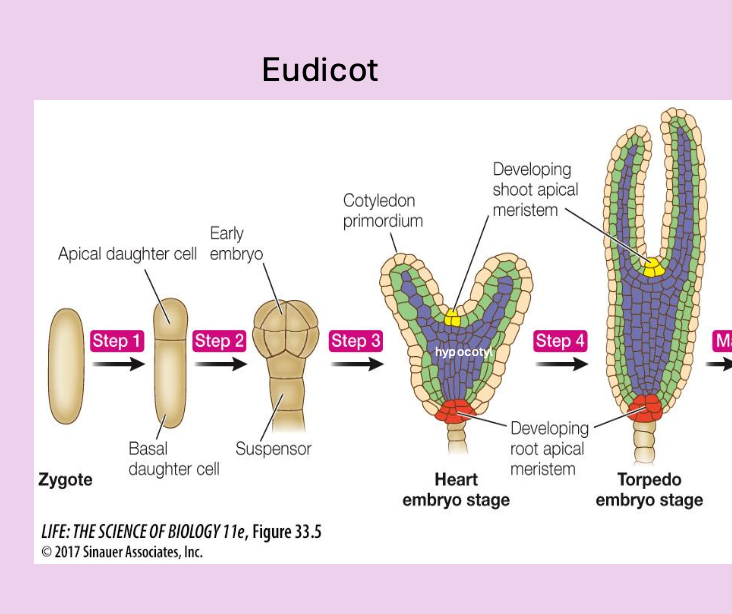
plumule
present in mature embryo
the embryonic shoot which contains a stem (epicotyl), the apical meristem at the tip,
and one or more young leaves

hypocotyl
present in the mature embryo
the stem below the cotyledon(s) that attaches it (or them) to the radicle
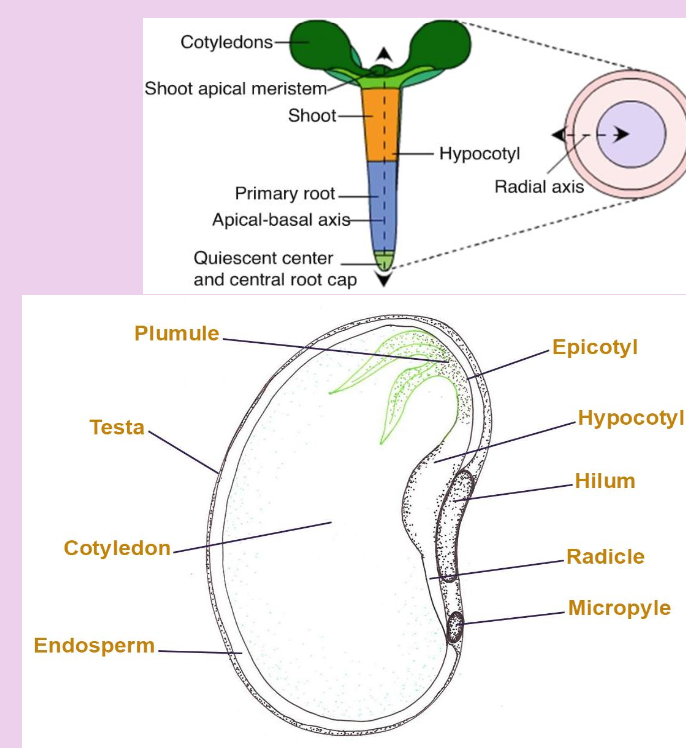
radicle
the embryonic root, which contains the root meristem at the tip
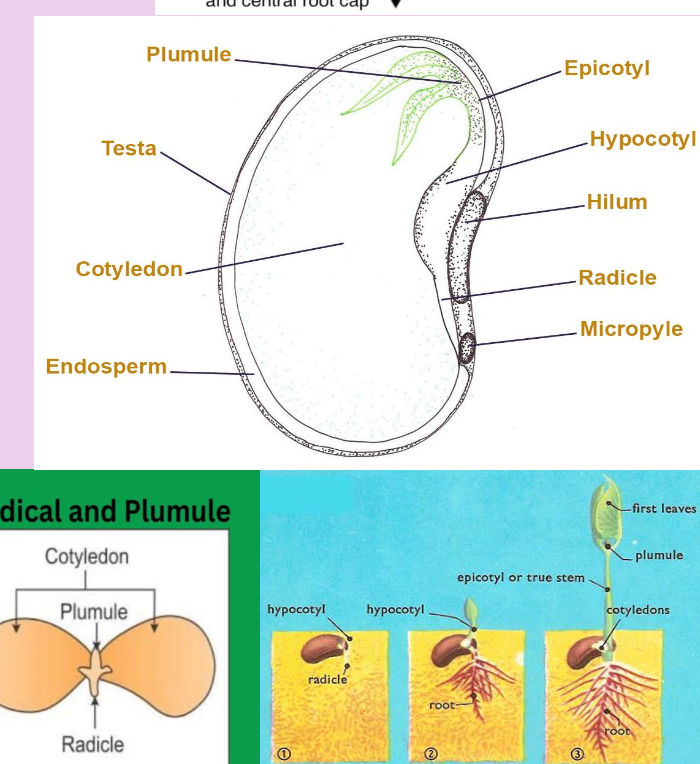
cotyledons
attached to the seed and radicle via the hypocotyl and to the plumule via the epicotyl.
In eudicots, two cotyledons. In monocots, one dominant cotyledon (scutellum) that is folded over the plumule
eucot cotyledons
may be large and fleshy, act as food reserves (like the endosperm) for the developing seed and germinating seedling once the endosperm runs out.
Or may be thin and membranous, helping the embryo absorb food from the endosperm and taking over photosynthetic functions upon germination
the monocot seed contains:
Scutellum – single cotyledon - dominant structure in the seed.
Acts as a bridge between endosperm and developing embryo by aiding in endosperm digestion and moving digested food to the embryo
Coleorhiza – protective sheath that covers the radicle
Coleoptile – protective sheath that covers the plumule
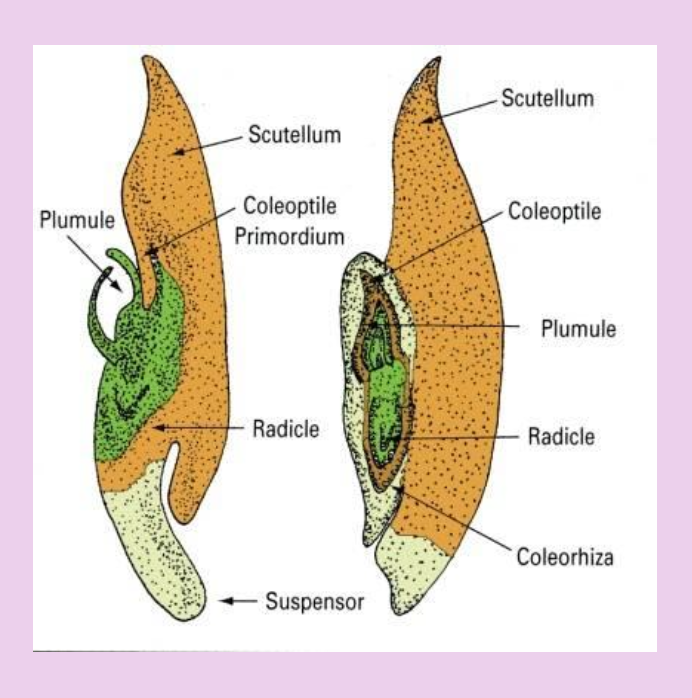
seed coat
outer protective coat.
Develops from the integuments of the ovule.
May be hard and impenetrable or thin and papery. Micropyle is sometimes still visible.
Also, may display a scar from where the seed was shed from the plant, called a hillum
seed maturation
at the end of embryogenesis, cell division in the mature embryo stops and the seed enters the final stage of development: maturation.
Reserves of food (starch, lipids, proteins) have accumulated in the endosperm.
Seed undergoes desiccation and loses 90+% of its water weight. Seed coat hardens.
quiescent pase
“resting” phase of a mature seed.
Once a quiescent seed imbibes water, it will germinate if environmental conditions are met
germination
resumption of embryonic growth. Depends on external and (sometimes) internal factors
external germination factors
sufficient water, oxygen, temperature, and (sometimes) light
internal germination factors
after maturation, some seeds will go dormant (primary dormancy) and will not germinate until internal (and external) conditions are met.
Even if environmental conditions are perfect, dormant seeds will not germinate until their dormancy is broken.
Dormancy may be imposed by the seed coat, by the embryo itself, or both
coat-imposed dormancy
seed coat may be too hard to imbibe requisite water, may be too rigid for the expanding radicle to penetrate, may contain inhibitors that suppress growth
embryo-imposed dormancy
ratio of hormones Gibberellic Acid (GA) and Abscisic acid
(ABA) can play a part.
ABA promotes dormancy
GA promotes germination by synthesizing the enzymes necessary to digest endosperm.
When GA concentration outweighs ABA concentration in the mature seed, embryo dormancy may be broken.
Some seeds must undergo a complex series of enzymatic changes before they will germinate, known as after-ripening
secondary dormancy
seeds that are no longer dormant, but encounter unfavorable conditions for germination will reenter a dormant state until environmental conditions are met
primary root
the first structure to emerge from the germinating seed is the radicle, which will develop into the primary root, or tap root.
As it grows it will form lateral roots, which will give rise to more lateral roots and form a branching root system in many gymnosperms and eudicots.
In monocots, the primary root is short lived, and the main root system originates from the crown of the plant (adventitious)
epigeal germination
eudicots
the second structure to emerge from the germinating seed is the hypocotyl, which bends to protect the apical meristem and elongates toward the soil surface in the shape of a hook, carrying the cotyledon and plumule above ground.
Once all reserves are digested from the cotyledon, they will wither and fall off.
In monocots,
the second structure to emerge from the germinating seed is the tubular single cotyledon (scutellum), which bends and elongates toward the soil surface in the shape of a hook, carrying the seed coat and plumule above ground.
The plumule emerges from the interior of the cotyledon (which is rolled up like a tube). Once all reserves are digested from the cotyledon, it will wither and die.
hypogeal germination
(eudicots)
the second structure to emerge from the germinating seed is the epicotyl, which bends to protect the apical meristem and elongates towards the soil surface in the shape of a hook, carrying the plumule above ground.
The cotyledon(s) remain below-ground, where they will eventually decompose.
In monocots
the first structure to emerge is the coleorhiza, and the radicle emerges from the center of this sheath.
The second structure to emerge is the coleoptile, and the plumule emerges from this sheath.
The scutellum and seed coat remain below-ground
Why is Evo-Devo an important field of modern biological study?
What three selective advantages do seeds provide to seed-bearing plants?
stored food
protective seed coat
facilitation of dispersal
What are the primary meristems of the developing seed, and what tissues do they
differentiate into? Where are these tissues located in the mature plant body, and what
functions do they serve?
protoderm—> outer tissue layer; precursor to the epidermis
ground meristem—> middle tissue layer; precursor to ground tissue
procambium—> inner tissue layer; precursor to vascular tissue such as xylem and phloem
How does early seed development differ between monocots and eudicots. Where is the
apical meristem located in each?
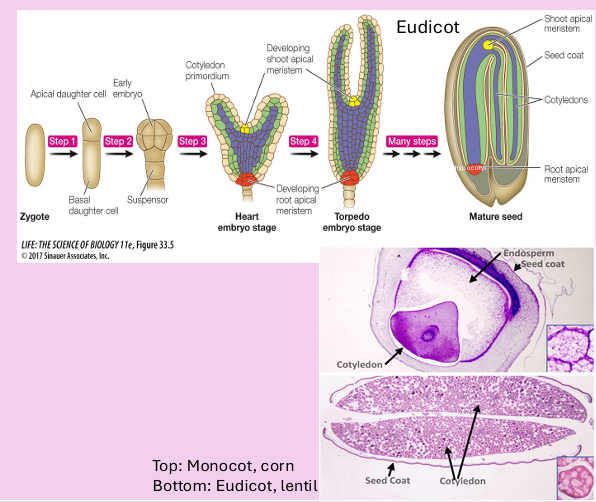
How can mutations affect the development of the suspensor and the radial pattern of an
embryo?
suspensor is important for supplying plant with nutrients and hormones like gibberellins
mutations causing proliferation of suspensor can disrupt normal embryogenesis and result in twin or triplet embryos
What metabolic changes occur inside a seed as it imbibes water?
water activates enzymes that promote germination
cells enlarge and division is initiated
What happens if a non-aquatic seed germinates underwater? Can it develop sucessfully?
Why or why not?
likely not
germination requires oxygen non-aquatic seeds don’t have adaptations to facilitate gas exchange
Apical meristems
cells in these regions retain the potential to divide after embryogenesis ends.
Found at the tips of all stems and all roots. Involved in primary growth – the extension of the
plant body. Produce two types of cells:
Initial
undifferentiated cells that maintain the meristem as a continuing source of new cells.
When initials divide, one sister cell remains in the meristem as an initial. The other becomes a
new body cell, or a:
Derivatives
may divide serval times near the meristem before differentiating into specific cell
types in the primary tissues
Shoot apical meristem
generates cells that create the stems, leaves, and flowers
Root apical meristem
generates cells that create the root system
Indeterminate growth structure
a plant’s ability to form new organs and continue to grow
during its entire lifespan
Developmental plasticity
a plant’s ability to modify its relationship with its environment by
modifying its phenotype
Development
the events that progressively form an organism’s body. Consists of three
overlapping processes:
Growth
an increase in size via a combination of cell enlargement and division
Morphogenesis
the assumption of a particular shape and form. Via the expansion of tissue, that
then differentiates into smaller units
Differentiation
the process by which cells with identical genetic constitutions become different
from one another, and from the meristematic cells from which they are derived. Via the
expression of specific genes (which are not expressed in other cell types), which is determined
by a cell’s final position in a developing organ
Tissues
cells form different structural and functional units. Distributed in a radial pattern
throughout the plant body, with specific arrangements that depend on the plant part, plant taxon,
or both
Permanent tissue
are not meristematic. Cells within permanent tissues are mature,
differentiated, and have often lost the ability to divide. They may be small or large, living or
dead, and have thin or thick cell walls
Tissue Systems
permanent tissues of vascular plants are grouped together by function into
three different systems:
Ground tissue
system consisting of the three ground tissues:
Parenchyma
most abundant cell in the plant body. Variable shape and size. Involved in
photosynthesis, storage, and secretion. Commonly occur as continuous masses. Living cells that
retain some ability to divide – responsible for initiating adventitious structures. Totipotent
Collenchyma
often occur in strands, typically elongated. Characteristic uneven, thickened, but
also flexible (non-lignified) cell walls. Often border veins in leaves, though often absent in
monocot leaves and stems. Supporting tissue of developing herbaceous organs
Sclerenchyma
dead cells that lack protoplasts. May form continuous masses or occur in small
groups or as individual cells. May develop in any part of the primary or secondary plant body.
Thick, often lignified secondary cell walls. Important strengthening and supporting elements in
mature organs. Two cell types:
Fibers – long, slender cells that occur in strands or bundles
Sclereids – shorter than fiber cells. Contain a branched central cavity.
Make up seed coats, nut shells, and fruit pits (“stone cells”)
Vascular tissue
system consisting of the two vascular tissues. Together, they form a continuous
system of vascular tissue extending throughout the plant body
Xylem
conducts water and dissolved nutrients from the root through the shoot. Principal
conducting cells are the tracheary elements which are elongated, have secondary walls, and are
nonliving. Two types:
Tracheids – (see Gymnosperms) less specialized (only tracheary element in seedless vascular
plants and gymnosperms)
Vessel elements – specialized conducting cells in angiosperms. Cell walls contain perforations –
areas lacking primary and secondary walls – perforation plates. Plates develop on cell wall
ends. Vessel elements join end-to-end, forming long, continuous columns called vessels
Phloem
primary food-conducting tissue. Responsible for the transport of sugars, amino acids,
lipids, micronutrients, hormones, messenger/signaling proteins and mRNA. Responsible for long
distance signaling. Also, the route of movement for viruses. Principle conducting element:
Sieve tube elements
living cells. Produce a cluster of pores – sieve tube plates – in cell wall.
Adjacent sieve tube cells are interconnected at the sieve tube plates. Characterized by thepresence of P-protein, which acts to plug sieve tube plates when wounded to prevent the loss of
phloem. Each sieve tube cell forms an association with a:
Companion cell – specialized parenchyma cell that derives from the same mother cell as the
sieve tube element cell to which it is paired. Share physical cytoplasmic connections to their
associated sieve tube element cell. If one dies, so will the other. Deliver substances to the sieve
tube cells like ATP and messenger proteins
Dermal tissue
system that consists of only one tissue type: epidermis (See card)
Epidermis
outer protective covering of the entire primary plant body. Cells are functionally and
structurally diverse and compactly arranged for mechanical protection. Upper (arial) cell walls
are covered in a waxy cuticle to reduce water loss. Contains some specialized cells: stomatal guard cells and trichomes
Stomatal guard cells
regulate small pores called stomata (singular: stoma) to control gas
exchange. Usually concentrated on leaf undersides
Trichomes
outgrowths on the epidermis (hairs) that can reflect solar radiation, lower leaf
temperature, reduce water loss, absorb water and minerals, and protect against herbivores
What internal factors determine the final form of a derivative cell?
differentiation is location dependent
different gene expression
Describe the three types of ground tissue - parenchyma, collenchyma, and sclerenchyma. How are they similar and different and what roles do they play in the plant body?
parenchyma: most abundant in plant body; photosynthesis, storage, and secretion
collenchyma: often occur in strands typically elongated often absent in monocot stems and leaves
sclerenchyma: dead cells that lack protoplasts

What element makes angiosperm xylem more specialized than gymnosperm xylem? What does this element look like and how does it function?
gymnosperms lack vessel elements
it’s a perforated cell wall on either end of the cell that joins end-to-end with the other cells
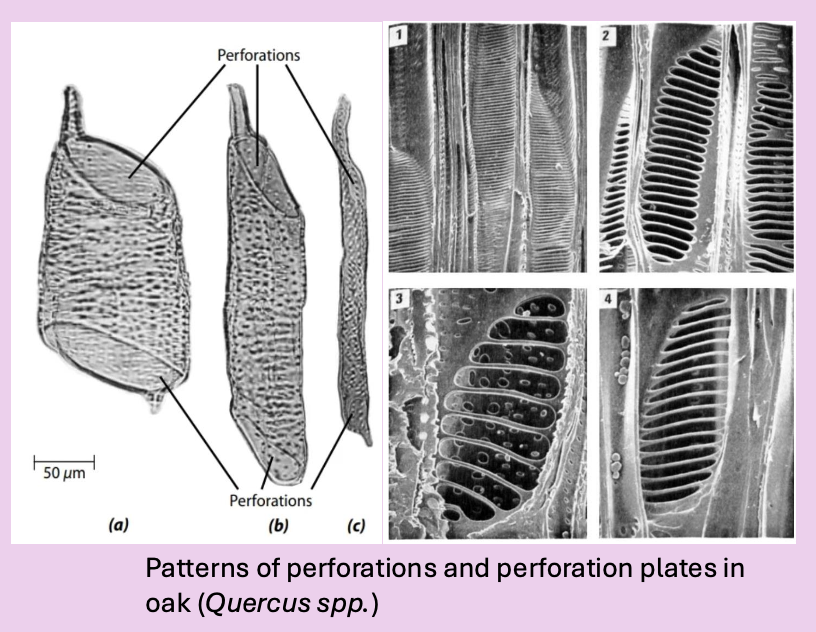
Root
the first structure to emerge from a germinating seed. Provides anchorage, storage,
and conductive and absorptive functions to the plant. Growth is a continual process that
only stops under adverse conditions and follows a path of least resistance, concentrating
in nutrient-dense areas. The young root consists of 3 regions of growth, with a gradual
transition between regions:
Region of cell division
the area of actively dividing cells (the apical meristem)
Region of elongation
cells elongate, resulting in an increase in length of the root
Region of maturation
ells differentiate and mature. Root forms root hairs,
tubular epidermal outgrowths that increase surface area
Internal structure consists of three concentric rings of tissue types, the Epidermis, Cortex,
and Vascular Cylinder
Epidermis
pecialized absorbing tissue in young roots due to highly permeable cell
wall
Cortex
represents the ground tissue system. Occupies the largest area within the Plastids are present, but they serve to store starch and are not usually
photosynthetic. Contains many air spaces (aerenchyma) for gas exchange.
Contains two distinct strips of tissue, the endodermis and the exodermis:
Endodermis
innermost cortical layer, tightly packed and lacks air spaces.
Characteristic presence of Casparian strips in cell walls. Helps to direct the
flow of water into the vascular cylinder
Casparian strip
band-like portion of the cell wall reinforced with
suberin and lignin, hydrophobic
Exodermis
outermost cortical layer, similar in structure to the endodermis Casparian strips embedded in cell walls. Reduces water loss and acts physical barrier against microbial attack
Vascular cylinder
contains the primary vascular tissues (xylem and phloem) and a non-
vascular tissue, the pericycle
Pericycle
completely surrounds the vascular cylinder. Also originates from procambium. Lateral roots arise in the pericycle. During secondary growth, gives rise to vascular and cork cambium
Xylem
solid core that occupies the center of roots. Ridgelike extensions
project into the pericycle. Number and shape of ridges is species dependent
Phloem
strands nestled between the xylem ridges
Root exudates
an array of substances secreted by the root into the rhizosphere
Rhizosphere
the soil directly surrounding living plant roots and that is influenced by root
activity (0.5-4mm border around each root)
Primary root (taproot)
develops from the embryonic radicle and grows straight down,
giving rise to lateral roots as it matures
Taproot system
a root system formed from a strongly developed primary root
Fiberous system
a root system found in monocots and some herbaceous eudicots where
the primary root is short-lived and the system develops from roots that arise from the stem
(adventitious roots), which then produce lateral roots. No one root is more prominent
than the others
Fine roots (feeder roots)
the roots actively engaged in the uptake of water and minerals.
Occur in the upper ~15cm of soil
Mycorrhizal fungi
soil fungi that form symbiotic relationships with plants by colonizing
fine roots. Fungi provide the plant with a wider network of access to water and nutrients,
while harvesting photosynthetic compounds from the plant in return
Root to Shoot ratio
a functional balance of mass maintained by the plant wherein the
amount of tissue in the root system is consistent with the amount in the shoot system
Root cap
tip of each root is covered with a thimble-like cap made of parenchymal cells
which protects the apical meristem
Mucilage
a highly saturated polysaccharide gel secreted by the periphery cells of the root
cap. Lubricates and hydrates the root
Border cells
periphery cells that are released and separate from plant tissue. Can remain
alive in the rhizosphere for weeks and exude messenger proteins to repulse or attract
microbial life or prevent desiccation. Border cells and their exudates account for 98% of
Carbon sequestered in soil
Root apical meristem
New root tissue develops at the tip of every root as the apical
meristem adds new derivatives. Divided into two regions:
promeristem and quiescent center
Promeristem
area of least differentiation. Composed of initials and their
immediate derivatives
Quiescent center
inactive middle area of the meristem. Can repopulate
meristematic tissue if it is damaged
Arial root
roots produced from above-ground structures, often serve support functions
Air root (pneumatophore)
roots developed out of soil (or water) for the purpose of
necessary gas exchange in soils with low oxygen content. Grow upwards, against gravity
Velamen
a specialized epidermal coating produced by the air roots of epiphytes to
aid in absorption of water vapor
Storage roots
specialized, fleshy roots that function as storage organs. Contain storage
parenchyma which store water, sugars, and other carbohydrates
What are two defense mechanisms roots use to protect against microbial attack?
the cortex in the epidermis acts as a physical barrier to defense from microbial attack
exudates attract beneficial microbes and repel bad ones
Shoot
the aboveground portion of the plant, consisting of stems, nodes and internodes,
and leaves